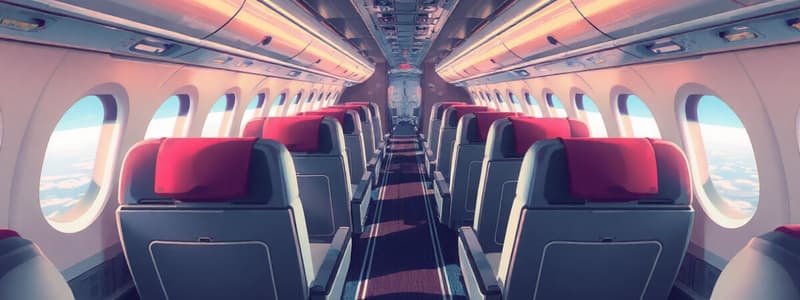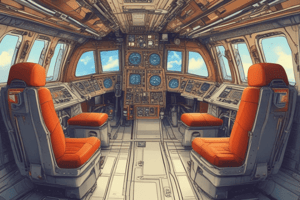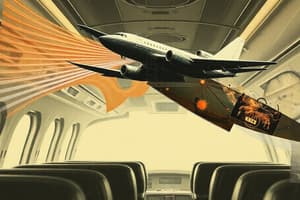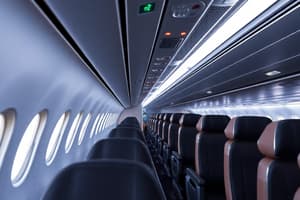Podcast
Questions and Answers
What is the primary reason for maintaining a cabin pressure altitude of approximately 8,000 feet or lower in an aircraft?
What is the primary reason for maintaining a cabin pressure altitude of approximately 8,000 feet or lower in an aircraft?
- To reduce the risk of rapid decompression in case of a system failure.
- To comply with international aviation regulations.
- To minimize the structural stress on the aircraft fuselage.
- To ensure passengers and crew have sufficient oxygen for full blood saturation. (correct)
Aircraft fuselages are typically designed to withstand both positive and negative differential pressure with equal strength.
Aircraft fuselages are typically designed to withstand both positive and negative differential pressure with equal strength.
False (B)
What components are combined to establish an airtight pressure vessel in an aircraft?
What components are combined to establish an airtight pressure vessel in an aircraft?
Compressible seals, grommets, and sealants
Control of cabin pressure is maintained by adjusting the rate at which air is allowed to flow ______ of the aircraft.
Control of cabin pressure is maintained by adjusting the rate at which air is allowed to flow ______ of the aircraft.
Which of the following factors is NOT a direct consideration when deciding on appropriate cabin altitude and rate of change values?
Which of the following factors is NOT a direct consideration when deciding on appropriate cabin altitude and rate of change values?
Maintaining cabin altitude at sea level during flight is always the best approach for maximizing passenger comfort, regardless of the aircraft's cruising altitude.
Maintaining cabin altitude at sea level during flight is always the best approach for maximizing passenger comfort, regardless of the aircraft's cruising altitude.
What is the consequence of establishing very low cabin altitudes at great heights?
What is the consequence of establishing very low cabin altitudes at great heights?
In aircraft design, what is the primary focus regarding pressure differential to save weight?
In aircraft design, what is the primary focus regarding pressure differential to save weight?
What is the primary source of air for cabin pressurization in turbine engine aircraft?
What is the primary source of air for cabin pressurization in turbine engine aircraft?
Using bleed air for cabin pressurization in a turbine engine aircraft increases the engine's overall power production.
Using bleed air for cabin pressurization in a turbine engine aircraft increases the engine's overall power production.
What is a drawback of using a supercharger for cabin pressurization in a reciprocating engine aircraft?
What is a drawback of using a supercharger for cabin pressurization in a reciprocating engine aircraft?
Turbochargers are driven by engine ________ gases.
Turbochargers are driven by engine ________ gases.
What is the primary advantage of using a turbocharger in a reciprocating engine aircraft?
What is the primary advantage of using a turbocharger in a reciprocating engine aircraft?
In a turbine engine aircraft, what is the purpose of the separate compressor driven by bleed air for pressurization?
In a turbine engine aircraft, what is the purpose of the separate compressor driven by bleed air for pressurization?
Superchargers can be located downstream of the fuel delivery system and still be used for pressurization in a reciprocating engine.
Superchargers can be located downstream of the fuel delivery system and still be used for pressurization in a reciprocating engine.
Match the aircraft engine type with its pressurization characteristic.
Match the aircraft engine type with its pressurization characteristic.
What is the primary function of a turbocompressor in turboprop aircraft?
What is the primary function of a turbocompressor in turboprop aircraft?
Bleed air is not used in the air cycle air conditioning and pressurization system of turbine-powered aircraft.
Bleed air is not used in the air cycle air conditioning and pressurization system of turbine-powered aircraft.
Name two key components in an air cycle air conditioning and pressurization system.
Name two key components in an air cycle air conditioning and pressurization system.
In isobaric mode, the pressurization system maintains the cabin altitude selected by the ______.
In isobaric mode, the pressurization system maintains the cabin altitude selected by the ______.
What happens when an aircraft climbs beyond a certain altitude and maintaining the selected cabin altitude in isobaric mode exceeds the airframe's design limits?
What happens when an aircraft climbs beyond a certain altitude and maintaining the selected cabin altitude in isobaric mode exceeds the airframe's design limits?
The constant differential mode maintains a constant cabin altitude regardless of the aircraft's altitude.
The constant differential mode maintains a constant cabin altitude regardless of the aircraft's altitude.
Which mode of operation is used for normal pressurization operations?
Which mode of operation is used for normal pressurization operations?
Match the pressurization mode with its description:
Match the pressurization mode with its description:
What is the primary function of the manual mode in an aircraft pressurization system?
What is the primary function of the manual mode in an aircraft pressurization system?
Cabin outflow valves only exist as single units combining the pressure regulating and valve mechanism.
Cabin outflow valves only exist as single units combining the pressure regulating and valve mechanism.
What component is used to prevent overpressurization in an aircraft cabin?
What component is used to prevent overpressurization in an aircraft cabin?
The outflow valve opens, closes, or modulates to establish the amount of air pressure maintained in the ______.
The outflow valve opens, closes, or modulates to establish the amount of air pressure maintained in the ______.
In aircraft with an electrically operated outflow valve, what component sends signals to position the valve?
In aircraft with an electrically operated outflow valve, what component sends signals to position the valve?
The cabin air safety valve is designed to maintain a constant pressure differential regardless of altitude.
The cabin air safety valve is designed to maintain a constant pressure differential regardless of altitude.
What is the purpose of the outflow valve in aircraft pressurization systems?
What is the purpose of the outflow valve in aircraft pressurization systems?
Match the component with its function in an aircraft pressurization system:
Match the component with its function in an aircraft pressurization system:
What is the primary function of the weight-on-wheels (WOW) switch during ground operations?
What is the primary function of the weight-on-wheels (WOW) switch during ground operations?
In automatic mode, the aircraft cabin pressurizes immediately to the flight altitude pressure as soon as the aircraft leaves the ground.
In automatic mode, the aircraft cabin pressurizes immediately to the flight altitude pressure as soon as the aircraft leaves the ground.
What are the three modes of operation for most aircraft pressurization control systems?
What are the three modes of operation for most aircraft pressurization control systems?
Maintenance testing of the pressurization system is conducted in ______ mode.
Maintenance testing of the pressurization system is conducted in ______ mode.
What is the typical pressure differential (psid) at which cabin air pressure safety valves on large transport category aircraft are set to open?
What is the typical pressure differential (psid) at which cabin air pressure safety valves on large transport category aircraft are set to open?
A negative pressure relief valve prevents external air pressure from exceeding cabin air pressure.
A negative pressure relief valve prevents external air pressure from exceeding cabin air pressure.
What initiates the start of cabin pressurization during the aircraft's ground operations?
What initiates the start of cabin pressurization during the aircraft's ground operations?
The standby mode of the pressurization system operates completely independently without using any of the primary system's components.
The standby mode of the pressurization system operates completely independently without using any of the primary system's components.
What is the primary purpose of pressurization dump valves on some aircraft?
What is the primary purpose of pressurization dump valves on some aircraft?
A negative pressure relief valve opens when the ambient pressure exceeds cabin pressure by more than about ______ psi.
A negative pressure relief valve opens when the ambient pressure exceeds cabin pressure by more than about ______ psi.
How is the outflow valve controlled in manual mode?
How is the outflow valve controlled in manual mode?
Match each cockpit indication with its function in advising the crew of pressurization variables:
Match each cockpit indication with its function in advising the crew of pressurization variables:
What prevents passengers from experiencing a harsh sensation when the outflow valves fully close during the takeoff phase?
What prevents passengers from experiencing a harsh sensation when the outflow valves fully close during the takeoff phase?
What is the primary reason for including a negative pressure relief valve on pressurized aircraft?
What is the primary reason for including a negative pressure relief valve on pressurized aircraft?
Pressurization dump valves are exclusively operated automatically by the aircraft's environmental control system.
Pressurization dump valves are exclusively operated automatically by the aircraft's environmental control system.
At what cabin pressure altitude will the pilot be informed via a warning indication and warning horn?
At what cabin pressure altitude will the pilot be informed via a warning indication and warning horn?
Flashcards
Pressurization functions
Pressurization functions
Functions integrated into the pressurization source, typically found outside the aircraft.
Cabin pressure altitude
Cabin pressure altitude
Maintaining a cabin pressure altitude at or below 8,000 feet to ensure adequate oxygen for passengers and crew.
Positive differential pressure
Positive differential pressure
The aircraft structure must be sealed to contain air at a pressure higher than the outside atmosphere.
Aircraft seals
Aircraft seals
Signup and view all the flashcards
Pressurized zones
Pressurized zones
Signup and view all the flashcards
Pressure control method
Pressure control method
Signup and view all the flashcards
Cabin altitude trade-offs
Cabin altitude trade-offs
Signup and view all the flashcards
Negative differential pressure risk
Negative differential pressure risk
Signup and view all the flashcards
Turbine Engine Operation
Turbine Engine Operation
Signup and view all the flashcards
Compressor Bleed Air
Compressor Bleed Air
Signup and view all the flashcards
Bleed Air Drawback
Bleed Air Drawback
Signup and view all the flashcards
Supercharger
Supercharger
Signup and view all the flashcards
Supercharger Drawbacks
Supercharger Drawbacks
Signup and view all the flashcards
Turbocharger
Turbocharger
Signup and view all the flashcards
Turbocharger Performance Tradeoff
Turbocharger Performance Tradeoff
Signup and view all the flashcards
Alternative Pressurization Method
Alternative Pressurization Method
Signup and view all the flashcards
Turbocompressor
Turbocompressor
Signup and view all the flashcards
Air Cycle Air Conditioning and Pressurization System
Air Cycle Air Conditioning and Pressurization System
Signup and view all the flashcards
Isobaric Mode
Isobaric Mode
Signup and view all the flashcards
Cabin Altitude
Cabin Altitude
Signup and view all the flashcards
Isobaric Range
Isobaric Range
Signup and view all the flashcards
Constant Differential Mode
Constant Differential Mode
Signup and view all the flashcards
Pressure Differential
Pressure Differential
Signup and view all the flashcards
Isobaric/Differential System
Isobaric/Differential System
Signup and view all the flashcards
Manual Mode (Pressurization)
Manual Mode (Pressurization)
Signup and view all the flashcards
Outflow Valve Control Switch
Outflow Valve Control Switch
Signup and view all the flashcards
Cabin Outflow Valve
Cabin Outflow Valve
Signup and view all the flashcards
Cabin Air Pressure Regulator
Cabin Air Pressure Regulator
Signup and view all the flashcards
Cabin Air Pressure Controller
Cabin Air Pressure Controller
Signup and view all the flashcards
Overpressurization Prevention
Overpressurization Prevention
Signup and view all the flashcards
Cabin Air Safety Valve
Cabin Air Safety Valve
Signup and view all the flashcards
Flight Altitude and Landing Altitude
Flight Altitude and Landing Altitude
Signup and view all the flashcards
Cabin Air Pressure Safety Valves
Cabin Air Pressure Safety Valves
Signup and view all the flashcards
Negative Pressure Relief Valve
Negative Pressure Relief Valve
Signup and view all the flashcards
Pressurization Dump Valves
Pressurization Dump Valves
Signup and view all the flashcards
Cabin Rate of Climb Indicator
Cabin Rate of Climb Indicator
Signup and view all the flashcards
Cabin Differential Pressure Indicator
Cabin Differential Pressure Indicator
Signup and view all the flashcards
High Cabin Altitude Warning
High Cabin Altitude Warning
Signup and view all the flashcards
Triple Combination Gauge
Triple Combination Gauge
Signup and view all the flashcards
Cabin Pressure Requirements
Cabin Pressure Requirements
Signup and view all the flashcards
Pressurization system modes
Pressurization system modes
Signup and view all the flashcards
Standby mode function
Standby mode function
Signup and view all the flashcards
Manual mode operation
Manual mode operation
Signup and view all the flashcards
WOW switch function (ground)
WOW switch function (ground)
Signup and view all the flashcards
Throttle position switch use
Throttle position switch use
Signup and view all the flashcards
Partial closing of outflow valve
Partial closing of outflow valve
Signup and view all the flashcards
Outflow valve action at takeoff
Outflow valve action at takeoff
Signup and view all the flashcards
Manual mode for maintenance
Manual mode for maintenance
Signup and view all the flashcards
Study Notes
- Aircraft pressurization makes flight possible in the hostile upper atmosphere.
- Critical design factors limit the degree of pressurization and the operating altitude.
Pressure of the Atmosphere
- Gases of the atmosphere (air) have weight, equivalent to 14.7 pounds for a one square inch column from sea level into space.
- Atmospheric pressure at sea level is 14.7 psi.
- Atmospheric pressure is also known as barometric pressure and is measured with a barometer, expressed in inches or millimeters of mercury.
- Measurements are taken by observing the height of mercury in a column exerted on a mercury reservoir.
- The barometer column is evacuated to prevent air from acting against the mercury rising.
- Aviators use interchangeable references to atmospheric pressure between linear displacement and units of force.
- Standard atmospheric pressure at sea level is 1 atmosphere (1 atm).
- Standard atmospheric pressure measurements are all equal to each other.
- Atmospheric pressure decreases with increasing altitude due to the shorter column of air being weighed.
- At 50,000 feet, the atmospheric pressure is about one-tenth of the sea level value.
Temperature and Altitude
- Temperature changes in the atmosphere are relevant to aviators.
- Most civilian aviation occurs in the troposphere (up to about 38,000 feet), where temperature decreases as altitude increases.
- The rate of temperature change is about -2°C or -3.5°F for every 1,000 feet of altitude increase.
- The upper boundary of the troposphere is the tropopause, characterized by a relatively constant temperature of -57°C or -69°F.
Pressurization Terms
- Cabin altitude is the equivalent altitude on a standard day with the same air pressure as inside the cabin.
- For example, cabin altitude is 8,000 feet (MSL) when the pressure inside the cabin is 10.92 psi.
- Cabin differential pressure is the difference between air pressure inside and outside the cabin, calculated as: Cabin pressure (psi) - ambient pressure (psi).
- Cabin rate of climb is the rate of change of air pressure inside the cabin, measured in feet per minute (fpm) of cabin altitude change.
Rate of Change of Pressure
- Aircraft commonly climb at 1000 feet per minute or faster, and engines maintain performance with changing atmospheric conditions.
- Rapid altitude changes affect the human body, causing physical pain and discomfort.
- When cabin pressure decreases violently, nitrogen and other dissolved gases in the blood expand into bubbles.
- Large, but non-violent, rates of change can cause:
- Sickness
- Abdominal expansion
- Ear expansion
Pressurization Issues
- Pressurizing an aircraft cabin is critical for making flight possible in upper atmosphere.
- Cabin pressurization systems ensure adequate passenger comfort and safety.
- Cabin pressure altitude is at approximately 8,000 feet or lower regardless of aircraft's cruising altitude to ensure sufficient oxygen for passengers and crew.
- Pressurization systems prevent fast cabin pressure changes that are uncomfortable or dangerous to people onboard.
- Circulating cabin air eliminates odors and stale air.
- Cabin air is heated or cooled, which is typically part of pressurization source.
Structural Considerations
- For pressurization, the section of the aircraft intended to hold air at higher pressure than the outside must be sealed.
- Compressible seals surround doors and combine with other grommets and sealants to create an airtight vessel.
- This includes the cabin, the flight and baggage compartments.
- Air gets pumped into the sealed area at a rate to raise pressure slightly above needed levels.
- The rate at which the air flows out of the aircraft controls this pressure.
- Controlling cabin to ground level values maximizes comfort.
- Loss payload and increased fuel consumption derive from the increased structural weight required to give the necessary strength to facilitate very low cabin altitudes.
Negative Differential
- Aircraft designs only consider the inside pressure being greater than the outside for weight-saving purposes.
- Fuselage designs do not account for reverse or negative differential pressure, although these can occur.
- Reverse pressure can occur if a perfectly sealed fuselage is suddenly dived to a low altitude, exceeding the internal pressure.
- Inward relief valves are set to open at a negative 0.5 psi to address this situation.
Pressure Relief Setting for Different Aircraft
- Secondary safeguards, such as safety valves, ensure the differential pressure doesn't surpass the maximum proof test figure if the normal equipment fails.
- Safety valves are only required when an error occurs.
- Inward relief valve will open should the pressure drop too low
- Boeing 707 Example:
- Normal Working Pressure: 8.6 psi
- Safety Valve Pressure: 9.42 psi
- Inward Relief Valve: 0.5 psi
Fuselage
- A key factor in pressurization is the fuselage's ability to endure the forces associated with the pressure difference inside versus outside.
- Differential pressure ranges from 3.5 psi for single-engine planes to 9 psi for high-performance jets.
Sources of Pressurized Air
- Varies mainly with engine type.
- Reciprocating aircraft have different sources than turbine-powered aircraft.
- Compression of air raises its temperature, thus, most pressurization systems include a means of cooling.
- This commonly comes in the form of a heat exchange that uses cold ambient air.
Reciprocating Engine Aircraft
- There are three sources of air typically used for pressurizing:
- Supercharger
- Turbocharger
- Engine driven compressor
Turbine Engine Aircraft
- The main principle involves the compression of large amounts of air to be mixed with fuel and burned so bleed air is relatively free of contaminants.
- Bleed air is a great source of air for cabin pressurization.
- Drawing air reduces engine power, so the amount of air bled for pressurization should be minimized but as much as needed.
Supercharger
- Mechanically engine driven that makes use of output power during the induction phase
- Due to taking engine power, these have a limited capability to increase engine performance
- Must be positioned upstream of the fuel delivery system, should it supply the intake and the cabin with air
Turbocharger
- Driven by engine exhaust gasses from a turbocharger impeller shaft, in a bearing housing
- Less air gets added during intake, resulting in lower engine performance
- Allows for high altitude flights, weather avoidance, and comfort without the need for extra oxygen
Pressurizing Using Turbine Compressor Bleed Air
- A separate compressor draws an ambient air intake
- This turbine gets rotated by another bleed airflow in a turbo compresser
- This bleed system allows for careful control of pressurizing air temp to provide high levels of comfort
Control of Cabin Pressure
- Cabin pressurization is controlled through two modes of operation:
- Isobaric Mode
- Constant Pressure Mode
- Isobaric mode maintains cabin altitude at a single pressure despite altitude changes while constant pressure differential maintains uniform pressure between the cabin and outside
- Ex. The flight crew may maintain a cabin altitude of 8,000 Ft.
Constant Differential Mode
- Pressure is always lower than the maximum differential pressure for which the airframe is designed.
- When in isobaric mode, the system maintains the altitude selected by the crew, but when the aircraft climbs to altitude, differential pressure above design results.
- The system automatically switches from isobaric to constant differential mode.
Cabin Rate or Climb
- The rate of change can be adjusted manually or automatically by the flight crew
- Typical rates of change are 300-500 fpm
- Modes of operation include automatic standby or manual operation.
Cabin Pressure Controller
- Controls the cabin air pressure by adjusting cabin altitude, rate of change, and barometric pressure
- This is controlled from the pressurization panel in the cockpit
- The controller then controls the regulators that adjust the position of the outflow valve at the rear of the vessel for cabin adjustments.
Modern Pressure Control Implementation
- Modern aircraft will often combine various strategies, be it pneumatic, electric, or electronic
- Selections for the barometric setting are set on this panel in the cockpit
- Electric signals are sent from the selector to the regulator that resides outside the pressurized area
- Modern system will often have the panel set to automatic, and a maintenance mode to override the automatic
- A switch is additionally there to control the position of the outflow valve
Cabin Air Pressure Regulator & Outflow Valve
- Cabin pressure is controlled through regulating airflow in and out of the cabin
- Outflow valves modulates to to control cabin pressure
- Pneumatically controlled regulators will use settings on the cockpit panel settings to adjust cabin air pressure
All Pneumatic Cabin Pressure Regulators
- Electric cabin pressure controllers can be used on air transport to manipulate the outflow valves
- Outflow valves can be positioned with signals from the cockpit panel selectors
Cabin Air Pressure Safety Valve Operation
- If the pressurization system malfunctions, key systems exist to prevent human or structural damage.
- A safety valve offers over-pressurization prevention
- A pressure relief valve set to predetermined pressure differential
Safety Valves
- All aircraft have safety valves set to open between 8 and 10 psid.
Negative Pressure Relief Valve
- Ensures that air pressure outside of the aircraft does not go below air pressure inside.
- A spring loaded relief valve helps to allow air to enter the system when needed.
- Equalization helps to maintain an ambient pressure around 0.3psi.
Pressurization Dump Valves
- Used by certain aircraft that are operated either automatically or manually by a switch
- Allows the removal of smoke, contamination, or control air in emergencies
Pressurization Gauges
- All pressurization systems commonly have a consistent three cockpit indications that commonly use light and alerts to advise the crew
- Cabin altimeter
- Altimeter rate of climb
- Cabin differential pressure indicator
- Cabins are also equipped with an orange PSI pointer on the right
- Should the cabin altitude exceed 10k feet, there will be indication and warning in the pilot's seat
Pressurization Operations
- Normal mode of operation is commonly in automatic operations with a standby controller if there is an error
- Manual mode allows for the crew to position the outflow valve directly, depending on what system (pneumatic or electric)
During Grand Ops
- Weight-on-wheels switches are used to control the safety valve to hold it open during take off
Throttle Switch
- Used to transition smoothly from an unpressurized to pressurized airplane system.
- If that WoW switch detects closed ground and power is given with the throttle, that means pressurization can occur while the ground is happening
During Take off
- Outflow valves often require a full close, but passengers barely notice due to the slight pressurization beginning early
During Flight
- The pressurization controller automates the pressurization components until the aircraft lands again
- Closing the WOW switch will then open the safety valves on the ground
Maintenance
- Maintenance testing typically occurs in testing manual and allows for total control from the technician
Studying That Suits You
Use AI to generate personalized quizzes and flashcards to suit your learning preferences.
Related Documents
Description
This quiz covers cabin pressurization in aircraft, including optimal cabin altitude, pressure vessel design, and factors influencing cabin pressure. It explores air sources for pressurization and the consequences of different cabin altitudes.




